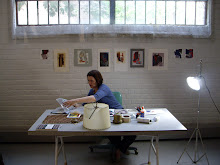“The aim of art is to create space - space that is not compromised by decoration or illustration, space in which the subjects of the paintings can live” (1)
Much of my work has been concerned with this problem in Abstraction outlined in Frank Stella’s collection of essays in Working Space. Stella has concerns about post modern Abstraction (especially post 1960), where grid locked, shallow, mannerist space has closed off fundamental drawing and composition principals.
My work seeks to understand space through re-configuration and directing the eye to tensions, whilst sustaining the picture plane. This architectonic process of building and understanding an authentic expression of form through drawing I believe connects with the experience of the human body. Abstraction to me is the synthesis of inner and outer pedagogical forms.
I believe that these concerns Stella raises can be resolved not purely through direct figurative sources but through ensuring variation in form is selected schematically, created through collage, accidental elements and pushed through drawing principles. I also believe that this approach to creating art through collage elements has not been completely explored within modern Abstraction.
Two completed art residences are linked with issues raised in Stella's Working Space:
The purpose for my art residency in Spain at Can Serrat International Art Centre was to understand how Catalan artists were influenced by Tachism, Art Informal, collage and Automatism and its influence on Abstraction. Within my work accidental marks and collage offers variation in form and can function as a figurative component in composition. Incorporating these elements or Happy Accidents I feel can stimulate the imagination and can open up the space in Abstraction and can guard against “The trouble in which recent Abstraction finds itself, its inability to project a real sense of space” (2). An exploration of the possibilities within collage, assemblage and arrangement of accidental forms had just started to be explored by Pollock and Gorky, De Kooning and many Catalan and Surrealist artists.
Barcelona in the heart of Catalonia (near Can Serrat International Art Centre) embraced this approach to art, even in its architecture. Gaudi’s buildings respond directly to the materials. His architectural plans are basically preconceived, but like nature they are flexible enough to embrace built in spontaneous, assembled additions and able to respond to a sense of place/materials used. With Gaudi’s influential architecture in Barcelona it is not surprising that Miro would respond to Surrealism and capitalize on collage/assembled elements to create form. This responsive approach to creating art I believe opened up possibilities for Abstract Artists in New York (in particular 1940’s – 1960’s) and helped shape Abstract Expressionism and Lyrical Abstraction. The reason for the two residencies Can Serrat International Art Centre and Point B Studio (New York) was to explore this connection between Catalonian art and development of Abstraction and explore issues in Stella’s Working Space.
I do hope to complete another residency in the near future to the desert region of Australia to understand first hand my own country and what Abstract Art can be created that reflects the uniqueness of Australia and expands on pictorial discoveries in the New World. I plan to use collage, monotype cardboard intaglio prints and Chine Colle as a direct medium to record my experiences outside of suburban Melbourne and expanding to the natural, untouched landscape and the sacred. This experience will hopefully assist with understanding the significance of Indigenous art and culture and can consulate thoughts on how Australian artists can sense and interpret place, identity and pictorial discoveries.
Spatial concepts can be defined broadly and can encompass intervals, place, cosmic, practical, physical areas; these are all valid explorations within art, but my focus is concerned with plastic picture-making issues that are virtual, linked directly with my sensibility, the materials and conditioned by the picture plane. The two main elements that are often in dialogue in my work are the contrasts between line/calligraphic mark and textured, expansive, vague areas. To me, Calligraphic mark making translates perception and through drawing, internal impulses can be transferred into the pictorial. In my art lines and marks function as skeletal structure and provide a direct opportunity for “lines to go for a walk”(3).
I hope to expand on understanding these textured, expansive, vague areas within my work and further study in Art Informal to understand marks and forms that are authentic in feeling and reflect an Inner Necessity (4).
(1) Stella, F. (1986), Working Space. Harvard University Press: Cambridge, MA, p.5
(2) Stella, Working Space. Cambridge, MA, Harvard University Press, 1986, p.46
(3) Moholy-Nagy (1968), Pedagogical Sketchbook, UK, Faber & Faber, 1968, p.16
(4) Kandinsky, Concerning the Spiritual in Art, UK, Dover, 1977, p.53

No comments:
Post a Comment